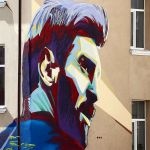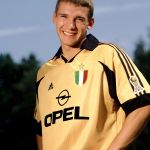
The evolution of football murals
Sao Paolo, Split and Naples are the new capitals of football street art
October 1st, 2020
A New York alley was recently plastered with murals to pay homage to five world-famous football legends. Graffiti used mainly for decorative purposes, which occupy the entire Mechanics Alley, under the Manhattan Bridge, and are the handiwork of a street artist who calls himself BKFoxx. The work was commissioned for the facade of "the Ground", a new indoor soccer field, and includes the monumental and hyper-realistic portraits of Franco Baresi, George Best, Johan Cruijff and Diego Aramando Maradona, to which is added the face of Sir Alex Ferguson. Even for non-football fans, the images are impressive in their sense of scale and attention to detail.
In Brazil, on the other hand, there is a fixed spectator on the stands of the Arena Brahma pitch in the favela of Jardim Peri. In addition to the kids who live in the northern district of San Paolo and wait their turn leaning against the wall to be able to play, since 2018 the playground - wedged between the numerous and overcrowded buildings in the area - is dominated by a huge mural depicting Gabriel Jesus smiling as he cheers after a goal. The work is 34 meters high and to create it it was necessary to paint the façade of twelve houses: some covered entirely in green, blue and yellow, form the backdrop to the bust of the Manchester City striker and the Brazilian national team, while mime the gesture of a phone call that he himself declared was dedicated to his mother Vera Lucia.
Jardim Peri's is a perfect example of "site specific" Street Art, that is, designed to make sense in a specific place. In a "site specific" work it is the physical context that completes the meaning of the drawing, which would appear incomprehensible in any other place. This case is illustrative for a very simple reason: Gabriel Jesus represents for many Brazilian teenagers the one who "made it", with his passion for football, to emerge from a context of degradation such as that of the favelas and become someone, and his presence a stone's throw from a football field serves as an inspiration for the young local players: "I hope that one day there will be a drawing of me next to his", explains Filipe Araujo, 11, a local talent who often passes his afternoons at the Brahma Arena.
Also in Brazil, on the occasion of the 2014 World Cup, the artist Paulo Ito chose the walls of Rio De Janeiro for his "Let them eat football" campaign to denounce the gap of almost 12 billion spent by the government for the preparations of 2014 World Cup while the country suffered from a poor national health system, the high costs of essential services such as education and public transport, and the lack of safety on the streets. Not to mention the death of 8 workers in the construction and modernization phase of the facilities to host the competition. Ito then decided to paint an undernourished child sitting at the table and crying because the only thing there is to eat - placed in plain sight on his ceramic plate - is a soccer ball.
Welcoming a global football event is at the same time also a great opportunity to show off, especially in those places not used to being in the spotlight. This is the case of the city of Kazan, which in 2018 hosted the Portugal hotel for the World Cup in Russia. To celebrate the arrival of Cristiano Ronaldo in the city, the artist Dmitry Chalov drew a huge mural with the face of the Lusitanian champion on the side of a building in front of the hotel. The celebration of a character - or in this case of a footballer - is definitely part of the characteristics of wall painting. But its usability, extended to anyone who happens to pass in front of a wall even by chance, in addition to the impossibility of moving it - due to the indissoluble link with the urban environment - can generate misunderstandings. It so happened that Leo Messi's Argentina, on the occasion of the round of 16 match against France, occupied the same structure in which CR7 and his teammates had stayed. To remedy the problem, a team of writers was immediately hired who in a few hours drew a mural of Messi next to that of the eternal rival. In addition, a writing was added at the top of the Portuguese's drawing, with a comic addressed to Messi: "I scored 4 goals. Can you beat that, Leo?"
Excluding the works linked to a specific event, "snapshots" by nature - as the definition of street art wants, made to impress and not to last - some murals are so tied to the city in which they are found that they become a real ornament urban. Have you ever been to Split? The hottest square in Croatian football is literally invaded by murals dedicated to Hajduk, which become more numerous and elaborate as you get closer to the area of the Poljud stadium.
When representation is so widespread, to the point of becoming obsessive, it ends up overlapping the urban space and contributing to its identity. For example, this is how Ferenc Puskás ends up becoming an integral part of the collective imagination of a city like Budapest. Idol of the great Hungary of the 1950s, the striker gives his name to the municipal stadium, is depicted in a statue a stone's throw from the Danube as he dribbles in double-breasted and tie, and his goal is represented in the gigantic mural that celebrates the historic success of the Magyars at England 6-3 in 1953.
Talking about Puskás in Budapest is a bit like telling Messi's Rosario, Maradona's Naples or Salah's Cairo. Players who have entered the pop culture of their respective places of origin (or of adoption), whose image becomes a characteristic feature of the city but also - on the contrary - an object of admiration and respect by local street artists. Their murals go against the trend with respect to the sense of street art, they try to deliver them to eternity, if not in the representation (since painting is always at risk of crumbling or being vandalized), at least by impregnating the walls and the air of their presence.
Born from protest movements as free creative expressions of the population against power, over time the murals have assumed more and more aesthetic value. Some Italian representations are iconic, such as Totti kissing the sky in the Monti district of Rome, or the huge stylized Maradona that stands out in the Spanish Quarter of Naples. Today they have also come to be commissioned by public bodies or large private bodies, such as the case of the double mural requested by the Lega Serie A on the occasion of the Coppa Italia final between Lazio and Atalanta in 2019. Jorit, a Neapolitan street artist, had to portray Ciro Immobile on the facade of a building in Ponte di Nona Vecchia, while the Sicilian artist duo Rosk & Loste was entrusted with a mural with Gasperini and his three tenors: Papu Gómez, Ilicic and Duván Zapata. Works created in the footsteps of Kamp Seedorf, nicknamed "The Banksy of the ball", who has covered Amsterdam with graffiti depicting football idols of the last 30 years.
A similar situation also for Inter, who in 2018 had "Interwall" created, a mural celebrating 110 years of Nerazzurri history. For each decade the fans have been able to choose the most iconic player, and among others the faces of Ronaldo, Javier Zanetti, Beppe Bergomi, Giuseppe Meazza and Giacinto Facchetti appear. However, the work suffered a fate typical of street paintings: the drawing was in fact smeared after just three days, with red paint, which could suggest a Milanist origin behind the gesture.
























































